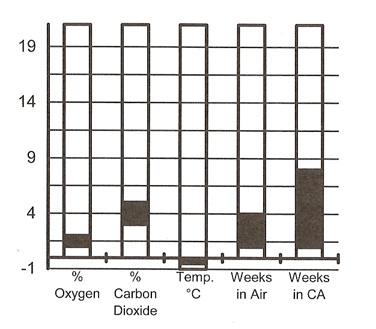
Optimum Relative Humidity: 90-95%
Benefits of CA: Low O2delays ripening and softening. Elevated СО2helps reduce internal breakdown in some cultivars. Some varieties of peaches can be shipped in 6% O2+ 17% CO2if they are kept near 0°C.
Benefits of Ethylene Removal: Freestone peaches produce substantial amounts of ethylene and are sensitive to ethylene. Ethylene removal can retard ripening and maintain firmness.
Special Treatments Before Shipping: Rapid cooling after harvest to temperatures less than 2°C is important to slow respiratory activity and retard ripening and decay. Hot water dips can help control brown rot and Rhizopus decay. 2.5 minutes in 52°C water is effective but skin injury can develop. Sanitation is imperative to reduce development and spread of decay-causing fungi.
Varietal Differences: There is significant variability among peach cultivars in their propensity to develop internal breakdown, in their shelf lives, and in their abilities to benefit from controlled atmospheres. Experience with individual varieties is necessary to develop optimal handling procedures. Varieties differ greatly in their storage potential in CA or in air.
Mixed Loads: Peaches should not be shipped with ethylene generating or ethylene sensitive commodities.
Cautions: O2less than 1% can cause off-flavors, skin browning and failure to ripen. CO2greater than 10% may cause flesh browning and off-flavors. Peaches should be kept near 0°C because at 4 to 10°C they are likely to develop internal breakdown. At temperatures greater than 10°C they will ripen rapidly and decay will develop. Internal breakdown is the limiting factor to long-term storage of freestone peaches. CA does not generally overcome this problem, although some atmospheres for some cultivars appear to be helpful.
ООО «Транстек» - Рефконтейнеры.рф ®

